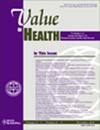Are Updated COVID-19 Vaccines Still Relevant for All Adult Age Groups? An Economic Evaluation of the Monovalent XBB.1.5 Vaccine in Australia
IF 4.9
2区 医学
Q1 ECONOMICS
引用次数: 0
Abstract
Objectives
There is a progressive decline in the relative effectiveness of updated COVID-19 vaccines. Surveillance reports in Australia have also shown a wide variation in the disease severity and mortality across age groups. This study aimed to perform a cost-utility analysis of the monovalent XBB.1.5 vaccine relative to no updated booster vaccine between September 2023 and August 2024.
Methods
A cost-utility analysis was performed using a Markov model from the healthcare system perspective for 3 different age groups (18-64, 65-74, and ≥75 years). Costs and outcomes with the monovalent XBB.1.5 vaccine were compared with no updated booster dose for 1 year. Health outcomes were expressed as quality-adjusted life years (QALYs), whereas costs were presented in 2023 Australian dollars. Aggregate distributional cost-effectiveness analysis and sensitivity analyses were performed. The willingness-to-pay threshold was set at A$50 000/QALY.
Results
The updated vaccine was dominant for the 18 to 64 years group and cost-effective for the 65 to 74 years group (incremental cost-effectiveness ratio [ICER] = A$10 786/QALY) and ≥75 years group (ICER = A$36,531/QALY) relative to no updated booster vaccine. The major determinants of the ICER was the vaccine uptake rate. There was inequality in health benefits between the older First Nations versus nonindigenous Australians. The results were robust to simultaneous changes in the parameters’ values.
Conclusions
The monovalent XBB.1.5 vaccine is cost-effective and still relevant for all adult age groups in Australia. Based on current evidence, the study findings support the promotion of booster vaccination for Australian adults.
更新的COVID-19疫苗是否仍然适用于所有成年年龄组?澳大利亚单价XBB.1.5疫苗的经济评价
目的:新型COVID-19疫苗的相对有效性呈逐渐下降趋势。澳大利亚的监测报告也显示,不同年龄组的疾病严重程度和死亡率差异很大。本研究旨在对单价XBB.1.5疫苗在2023年9月至2024年8月期间相对于没有更新的加强疫苗进行成本效用分析。方法:采用马尔可夫模型从医疗保健系统的角度对三个不同年龄组(18 - 64;65 - 74;≥75岁)。单价XBB.1.5疫苗的成本和结果与未更新一年加强剂量的疫苗进行了比较。健康结果以质量调整生命年(QALY)表示,而成本以2023年澳元表示。进行了总体分布成本-效果分析和敏感性分析。支付意愿门槛设定为5万澳元/QALY。结果:更新疫苗在18 - 64岁组中占主导地位,在65 - 74岁组(增量成本-效果比[ICER] = 10,786澳元/QALY)和≥75岁组(ICER = 36,531澳元/QALY)相对于未更新加强疫苗而言具有成本效益。ICER的主要决定因素是疫苗吸收率。老年第一民族与非土著澳大利亚人之间在保健福利方面存在不平等。结果对参数值的同时变化具有鲁棒性。结论:单价XBB.1.5疫苗具有成本效益,适用于澳大利亚所有成人年龄组。根据目前的证据,研究结果支持促进澳大利亚成年人加强疫苗接种。
本文章由计算机程序翻译,如有差异,请以英文原文为准。
求助全文
约1分钟内获得全文
求助全文
来源期刊

Value in Health
医学-卫生保健
CiteScore
6.90
自引率
6.70%
发文量
3064
审稿时长
3-8 weeks
期刊介绍:
Value in Health contains original research articles for pharmacoeconomics, health economics, and outcomes research (clinical, economic, and patient-reported outcomes/preference-based research), as well as conceptual and health policy articles that provide valuable information for health care decision-makers as well as the research community. As the official journal of ISPOR, Value in Health provides a forum for researchers, as well as health care decision-makers to translate outcomes research into health care decisions.
 求助内容:
求助内容: 应助结果提醒方式:
应助结果提醒方式:


